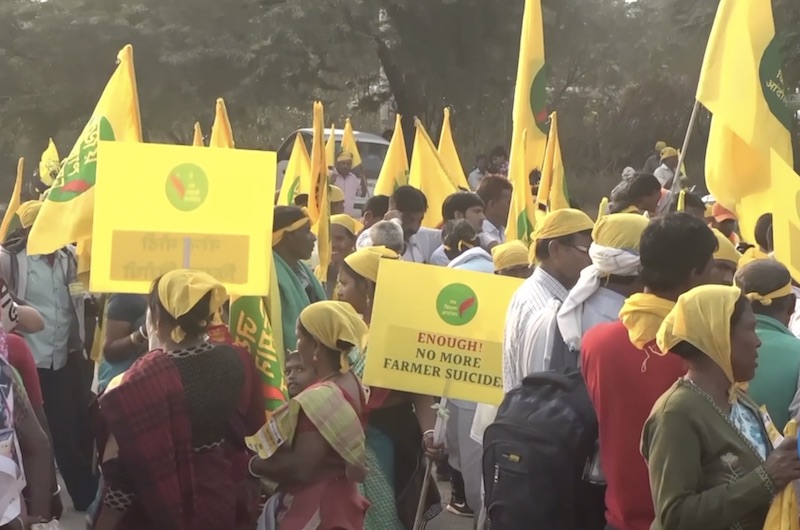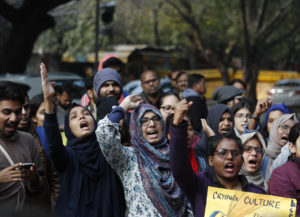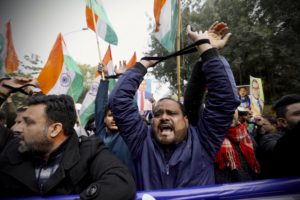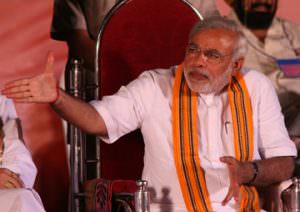Millions of Farmers Could Turn the Tide Against India’s Right-Wing Regime
The economic despair of a huge percentage of farmers in India is not likely to help the government as elections draw nearer. Indian farmers march toward New Delhi in a protest in December. (VOA screen shot)
Indian farmers march toward New Delhi in a protest in December. (VOA screen shot)
This article was produced by Globetrotter, a project of the Independent Media Institute.
As India’s 2019 general election approaches, Prime Minister Narendra Modi’s Bharatiya Janata Party (BJP) is attempting to garner support among the country’s rural populace, which represents around two-thirds of the country’s total population.
Modi’s efforts to court India’s rural voters take place amid large-scale demonstrations held by Indian farmers. The wave of protests culminated last November, when thousands of farmers from across India gathered in New Delhi to demonstrate outside the Parliament building demanding a special three-week joint session on India’s agrarian crisis. The march—named the Kisan Mukti March, or Farmers’ Freedom March—was coordinated by the All India Kisan Sangharsh Coordination Committee, a coalition group of more than 140 farmer organizations, formed in June 2017.
The recent demonstrations have set the tone for this year’s general elections, reminding governments that there is a political cost to ignoring rural India.
India’s Agrarian Crisis: Debt, Suicide and Government Neglect
Over the past several months, millions of subsistence farmers, many with less than five acres of land, have staged protests demanding higher prices for their crops (also referred to as minimum support prices) and debt forgiveness.
Rural farmers in India, since the early 1990s, have had very limited access to credit from the country’s banks, a major problem for a livelihood that is cyclical and prone to a range of environmental setbacks. Without public-sector bank loans to depend on, small farmers were forced to turn to predatory informal lenders who charge annual interests of up to 60 percent.
Under the BJP government, economic conditions for Indian farmers have worsened due to rising input prices, weak government support systems, climate change–induced crop failures, declining commodity prices and stagnant farm incomes, forcing many farmers to give up their land.
P. Sainath, a renowned scholar and journalist who focuses on India’s rural economy, observes that India’s agrarian crisis has been marked by a sharp decline in the country’s full-time farmer population and has ushered millions into the ranks of the agrarian underclass of landless laborers.
“This means that countless once-landed farmers have lost their greatest asset—their land,” P. Sainath, a senior fellow with the Tricontinental: Institute for Social Research, goes on to note.
An equally alarming feature of rural distress among Indian farmers is the rising rate at which farmers are committing suicide as a result of their inability to pay off existing loans.
Due to India’s deep-seated agrarian crisis, a suicide epidemic has struck the country, with an unprecedented number of farmer suicides taking place across the subcontinent.
“We never heard of farmer suicides due to debt before the 1990s in India. Only in 1997, when the neoliberal attack on farmers took effect did you hear of debt-driven suicides, which by now exceeds more than 300,000 [farmers],” Marxist economist Utsa Patnaik said in a recent interview coordinated by the Thimar Collective, a research collective based out of Lebanon, which publishes and syndicates content regarding agriculture, environment and labor in the Arab world.
In efforts to ease agrarian hardships, Indian farmers are demanding that government officials implement the recommendations issued in a 2004 government-nominated commission (known as the Swaminathan Commission), which was created in order to identify solutions to the problems faced by farmers in India.
However, 15 years have passed since its release, and Indian lawmakers have yet to hold a serious debate on the report’s findings and recommendations.
BJP Seeks to Win Back the ‘Farm Vote’
Meanwhile, as part of its 2019 electoral campaign strategy, the BJP is already disingenuously positioning itself as the advocate of farmers in an effort to garner support among the country’s rural population, who plays an important role in determining the outcome of the country’s upcoming elections.
Typically, in order to temporarily appease agrarian constituencies, ruling parties at both state and national levels placate rural discontent by granting subsidies on farm inputs such as energy and fertilizer.
Most recently, however, farmers have taken to the streets to demand that the Modi administration deliver on several long-standing policy pledges, including: the cancelation of more than $50 billion of farm debt; the implementation of a procurement formula guaranteeing farmers a return of at least 1.5 times their costs of production; and promises to double farm incomes by 2022.
Unfortunately for farmers, since Modi came into office, debt among agricultural households has intensified, while farm incomes remained stagnant.
According to a 2018 survey, more than half the agricultural households in the country have outstanding debt, and farm incomes have stayed largely the same.
“The last 25 years have been pure hell for the agrarian communities. Millions have drowned in debt, lost land to corporations and moneylenders, millions have seen their livelihoods collapse and migrated out of the occupation or to other villages, towns and cities—in search of jobs that are not there,” P. Sainath said via email.
Empty Promises
Due to Modi’s failure to make good on a long list of promises, some analysts believe that he will be unable to replicate the same level of support he received from Indian farmers during his 2014 electoral campaign.
The BJP’s failure to address the diverse demands of India’s enormous rural population was regarded by many experts as one of the underlying factors that led to the party’s electoral defeats in the important 2018 state assembly elections of Rajasthan, Madhya Pradesh and Chhattisgarh.
Instead, the Indian National Congress Party (INC) victory over the BJP in the states of Rajasthan, Chhattisgarh and Madhya Pradesh suggest that Modi’s attempts at raising farm wages have been ineffective in generating support for the BJP at the ballot box.
The fact that agriculture accounts for 44 percent, 65 percent, and 62 percent of employment in Rajasthan, Chhattisgarh and Madhya Pradesh, respectively, further indicates that the recent electoral shift is likely indicative of growing disenchantment among rural voters with regard to the BJP’s election promises to raise farm wages.
PM Modi Maintains National Popularity
However, despite mounting frustration among some the country’s rural voters, in the weeks leading up the country’s national elections, Modi still appears on course to win another five-year term, with around a 60 percent job-approval rating, according to at least one recent polling survey.
Modi led his right-wing, Hindu nationalist Bharatiya Janata Party to a sweeping victory in 2014.
During his campaign for a second term, in order to deflect attention away from growing dissatisfaction around worsening economic conditions, particularly among the country’s rural population, Modi is placing Hindu nationalism as the centerpiece of his campaign platform, appealing to voters based on religious identity politics.
Some electoral analysts have even speculated that the most recent military spat between India and Pakistan serves as a distractive measure in efforts to bolster Hindu nationalist sentiment, which would subsequently generate broader national support for the Modi administration as he heads into the elections.
Regardless of this year’s electoral outcome, one thing is for certain: As India’s agrarian crisis deepens, so too will the social unrest, which may force future elected officials to take action on the growing demands of India’s powerful rural populace.
Your support is crucial...As we navigate an uncertain 2025, with a new administration questioning press freedoms, the risks are clear: our ability to report freely is under threat.
Your tax-deductible donation enables us to dig deeper, delivering fearless investigative reporting and analysis that exposes the reality beneath the headlines — without compromise.
Now is the time to take action. Stand with our courageous journalists. Donate today to protect a free press, uphold democracy and uncover the stories that need to be told.





You need to be a supporter to comment.
There are currently no responses to this article.
Be the first to respond.